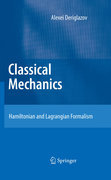
Hamiltonian formalism of classical mechanics is the basis of a few powerful mathematical methods, widely used in theoretical and mathematical physics. In this book we have collected the basic facts of the Hamiltonian mechanics as well as the related topics: canonical transformations, integral invariants, potential motion in geometric setting, symmetries and the Noether theorem. Only theelementary mathematical methods are used in the exposition of the material. The only prerequisites are linear algebra, multivariable calculus and some familiarity with the Lagrangian formulation of classical mechanics. Other mathematical constructions involved are explicitly described and explained, so the book can be a good starting point for the undergraduate student new to this field. At the same time we have tried, where possible, to replace the intuitive motivations by explicit proofs and direct computations, preserving the level of rigor that makes the book useful for the graduate students intended to work in one of the branches of a vast field of theoretical physics. With worked examples, 55 end of chapter exercises and chapter summaries The equivalence of various definitions of the canonical transformation is proved explicitly, in contrast to competing books Discussion of (global) symmetries and the Noether theorem in the framework of classical mechanics gives a new approach not covered by most mechanics textbooks INDICE: Sketch of Lagrangian Formalism.- Hamiltonian Formalism - CanonicalTransformations on Two- Dimensional Phase Space - Properties of Canonical Transformations - Integral Invariants - Potential Motion in a Geometric Setting -Transformations, Symmetries and Noether Theorem.- Hamiltonian Formalism for Singular Theories.
- ISBN: 978-3-642-14036-5
- Editorial: Springer
- Encuadernacion: Cartoné
- Páginas: 388
- Fecha Publicación: 01/09/2010
- Nº Volúmenes: 1
- Idioma: Inglés
